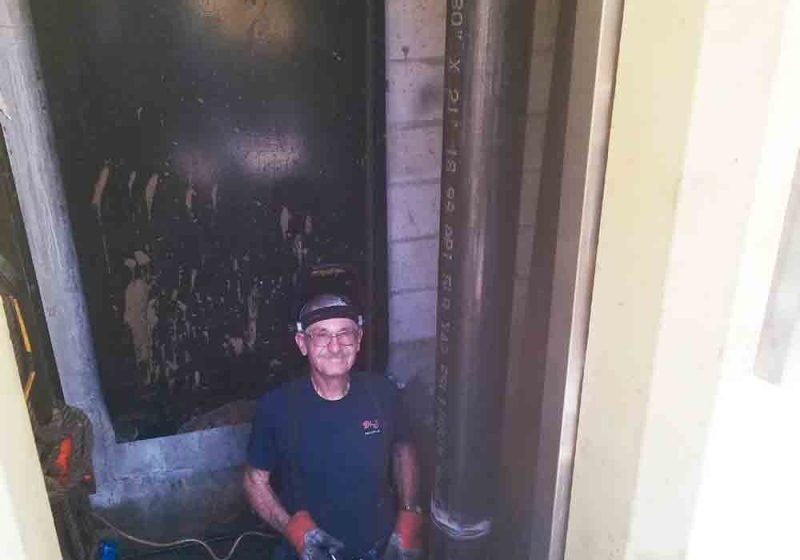More than 300 Otis units facilitate the journey of millions of Muslims on Jamarat Bridge during the Haj
Looking at photos and videos of the Hajj, the Islamic pilgrimage to the holy city of Mecca, Saudi Arabia, gives some idea of the scope of the event, the largest annual gathering of people in the world.[1] The sheer number and density of people is mind-boggling. Thousands of heads viewed from above form a cohesive mass that resembles an intricately patterned fabric. It is in and around Mecca, over five days, that approximately three million Muslims gather to perform a series of rituals that comprise the five pillars of Islam, one of which is the “stoning of the devil,” which takes place inside the Jamarat Bridge structure in Mina.
Every Muslim who is physically and financially able is required to complete the Hajj at least once in their lives. With Islam the fastest-growing religion in the world,[2] Hajj attendance is also growing. Approximately 300,000 faithful attended when the original, two-level pedestrian bridge was built in 1963. By 2005, the number of attendees had increased sevenfold to more than two million, Otis Middle East Managing Director Maged Nagib tells ELEVATOR WORLD. Up to 300,000 people crossed the bridge every hour.
The pilgrimage occurs from the eighth to 12th days of the Islamic calendar. Since the Islamic calendar is lunar and about 11 days shorter than the Gregorian year, Hajj dates vary from year to year.[1] This year’s event fell on August 30-September 5. The event typically draws people from approximately 120 countries who speak 170 languages.[2] Dr. Osama Al-Bar, mayor of Mecca, observes Hajj is more crowded than the World Cup, which typically draws no more than 400,000 people.
In 2007, the growing number of attendees led to construction of a new five-level bridge boasting three expanded stoning-ritual walls; a new air-conditioning system; and an “extraordinary” people-moving system consisting of 308 escalators and six passenger, two ambulance and two helipad elevators. “With something this important to Muslims worldwide, it is vital that outside factors do not disturb the true meaning of Hajj,” Nagib says. Although tragic accidents related to Hajj still happen, few, if any, involve the bridge’s elevator/escalator system. Expanding the bridge was an “important step forward” in improving safety during the pilgrimage, Nagib observes.
Dr. Keith Still, professor of Crowd Science at Manchester Metropolitan University, who worked with Saudi authorities on the bridge’s design, observes crowds during Hajj are, by nature, potentially dangerous. “Any large crowd, obviously, has a large potential for risk,” Still states, continuing:
“People have a finite size. You can only get so many people into a particular space. [On the bridge during Hajj], the crowd is packed so tightly together that people can’t breathe. Before the upgrade, we recorded 11-15 people per square meter. That’s unheard of, and extremely dangerous, because any trips and falls in that environment can be fatal.”
The expansion resulted in an average of 1 m2 per person — still tight, but manageable.
The Otis transportation system at the Jamarat Bridge is a real workhorse, running 24 hr. a day. Still says that with a typical transportation system, you might see an hour or so of peak usage during rush hours, but the Hajj system endures three solid days of peak time.
The system’s size means that each pilgrim’s passage is facilitated by at least one of the hundreds of pieces of people-moving equipment, which are tended to by approximately 200 Otis employees, including technicians, engineers and supervisors. They work around the clock to monitor and service the equipment. During the off season, the equipment gets a thorough evaluation, and needed parts are replaced four times a year. “The average response time of this team during Hajj is 5 min.,” Nagib observes. “The Makkah Development Authority [which operates the bridge] has recognized Otis for its contributions to the Hajj every year since 2012.”
Those contributions are significant. Nagib states:
“There are 28 escalators in each of the 11 towers in the main bridge structure and 20 in the two external accesses to the bridge — the Sidki and Sabak links. Each escalator can be used to transport pilgrims up or down in the structure depending on the flow of the crowd and guidance from the security force on the ground. The passenger elevators are heavy-duty Gen2® units capable of carrying weights of up to 1274 kg at speeds of up to 1.75 mps. The escalators transport as many as four million passengers daily. For 2017’s Hajj, an estimated 12.5-15 million rides took place.”
Intense maintenance, repair and testing is performed in the months leading up to Hajj, so that “when the season arrives, God willing, there will be no malfunctions,” states Otis service technician Abdullah Saad Fahad.
Crowd-safety and logistics challenges radiate far out from the Jamarat Bridge, with many pilgrims staying in tent villages nearby and having to make their way to and from the bridge from different directions. To improve the logistics of traversing the ramps, moving walks could be installed on the ramps in coming years, says Sameh Adel Mohammed Fahmy Murad, Field Service director, Otis Saudi Arabia, and director of the Metro and Jamarat Bridge project.
“Huge opportunities lie ahead,” says the narrator of an Otis Jamarat Bridge mini documentary. The Saudi government now has a project in the works to double bridge capacity to six million people. The narrator continues by saying, “Companies like Otis have a huge part to play in ensuring every one of the Muslim faithful can fulfill their dream of Hajj and return safely to their homes around the world.”
References
[1] Wikipedia. “Hajj” (en.wikipedia.org/wiki/Hajj).
[2] “The Changing Global Religious Landscape,” Pew Research Center, April 5, 2017.
[3] “Otis Jamarat Bridge Mini Documentary” (youtube.com/watch=PtWXsBhIcPE).
Get more of Elevator World. Sign up for our free e-newsletter.









